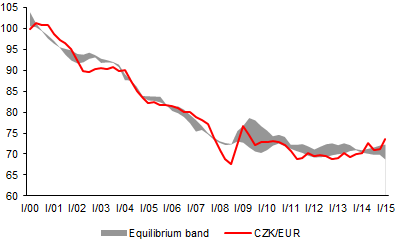The equilibrium koruna-euro exchange rate
Equilibrium exchange rate estimates are important for central banks above all because deviations of the exchange rate from its equilibrium level affect the exchange rate component of the monetary conditions.1 If the exchange rate is overvalued relative to its equilibrium level, it reduces the price competitiveness of the domestic economy, slows its growth and ultimately causes inflation to decline. An undervalued exchange rate acts in the opposite direction.
Economic theory offers a whole range of approaches to determining equilibrium exchange rate levels. The BEER (behavioural equilibrium exchange rate) approach takes into account a set of key variables affecting the long-run real exchange rate, for example the productivity differential and the inflow of foreign investment, which expands production capacity. The FEER (fundamental equilibrium exchange rate) approach is based on the condition of identifying both the internal and external equilibrium of the economy simultaneously.2
The range of the real equilibrium exchange rate estimates is obtained as the range of the midpoints of the estimates according to the BEER and FEER models (see Chart 1).3 A significant trend of real equilibrium appreciation of the koruna was observed in 2000–2008. In this period, the Czech economy recorded higher economic growth rates than the euro area, supported by massive inflows of foreign investment. This was reflected in visible convergence towards the euro area level. At the same time, successful implementation of monetary policy led to low inflation rates, so the equilibrium real appreciation of the koruna was reflected in nominal appreciation against the euro.
Chart 1 (BOX) CZK/EUR real equilibrium exchange rate
The long-term trend of real appreciation of the koruna exchange rate halted after 2011 at a level that showed signs of slight overvaluation until November 2013
(first quarter = 100; CNB calculation)

Note: Equilibrium estimates according to the BEER and FEER models deflated by the index of producer prices in manufacturing.
The strongest overvaluation of the koruna-euro exchange rate was observed in 2002 and 2008. By contrast, the exchange rate was undervalued in 2000–2001 and again in 2006–2007. The pace of real convergence almost halted after the onset of the global financial, economic and subsequently also European debt crisis, but the exchange rate returned to an appreciating trend following a temporary weakening in late 2008 and early 2009. From 2011 to November 2013, this led to slight overvaluation of the koruna in both real and nominal terms (see Chart 2).
Chart 2 (BOX) CZK/EUR nominal equilibrium exchange rate
After the CNB adopted its exchange rate commitment of CZK 27 to the euro in November 2013, the exchange rate weakened to its equilibrium level; according to one method it is currently still at its equilibrium level and according to another it is slightly undervalued
(CNB calculation)

Note: Equilibrium estimates according to the BEER and FEER models.
The decision of the CNB Bank Board to start using the exchange rate as an additional monetary policy instrument (as from 7 November 2013) and the adoption of an asymmetric exchange rate commitment at CZK 27 to the euro caused the exchange rate to return to its equilibrium levels(see Charts and 2). According to the BEER method, the equilibrium exchange rate is currently at levels corresponding to the exchange rate commitment. The FEER-based estimate points to slight undervaluation of the exchange rate, reflecting the Czech Republic’s slight current account surplus as opposed to the assumed sustainable deficit of 2.5% of GDP. 4, 5
Overall, the estimates show that no strong fundamental pressures for the exchange rate to appreciate to the levels seen before the CNB adopted its exchange rate commitment should arise following the return to the standard monetary policy regime.
1 See Box 3 in Inflation Report II/2015.
2 Internal equilibrium corresponds to the potential output path calculated using the Cobb-Douglas production function. External equilibrium corresponds to the sustainable path of the ratio of the current account deficit to GDP.
3 In reality, however, the degree of uncertainty of these estimates is considerably higher than that indicated by the range shown, as both methods have relatively wide confidence intervals.
4 In its Article IV consultation in spring 2015, the IMF arrived at qualitatively the same conclusions. It stated that “the current account balance is stronger than the norm of 1 percent of GDP deficit, indicating a marginal undervaluation of 3 percent in 2014”. At the same time, however, a calculation using a different method indicated that the koruna was overvalued by more than 10%, so overall the IMF assessed the koruna exchange rate as being “broadly in line with fundamentals”.
5 The estimate also does not take into account the fact that the current account surplus reflects, among other things, a strong inflow of money from EU funds, which, however, is as a rule converted into CNB international reserves and so does not affect real flows on the forex market.